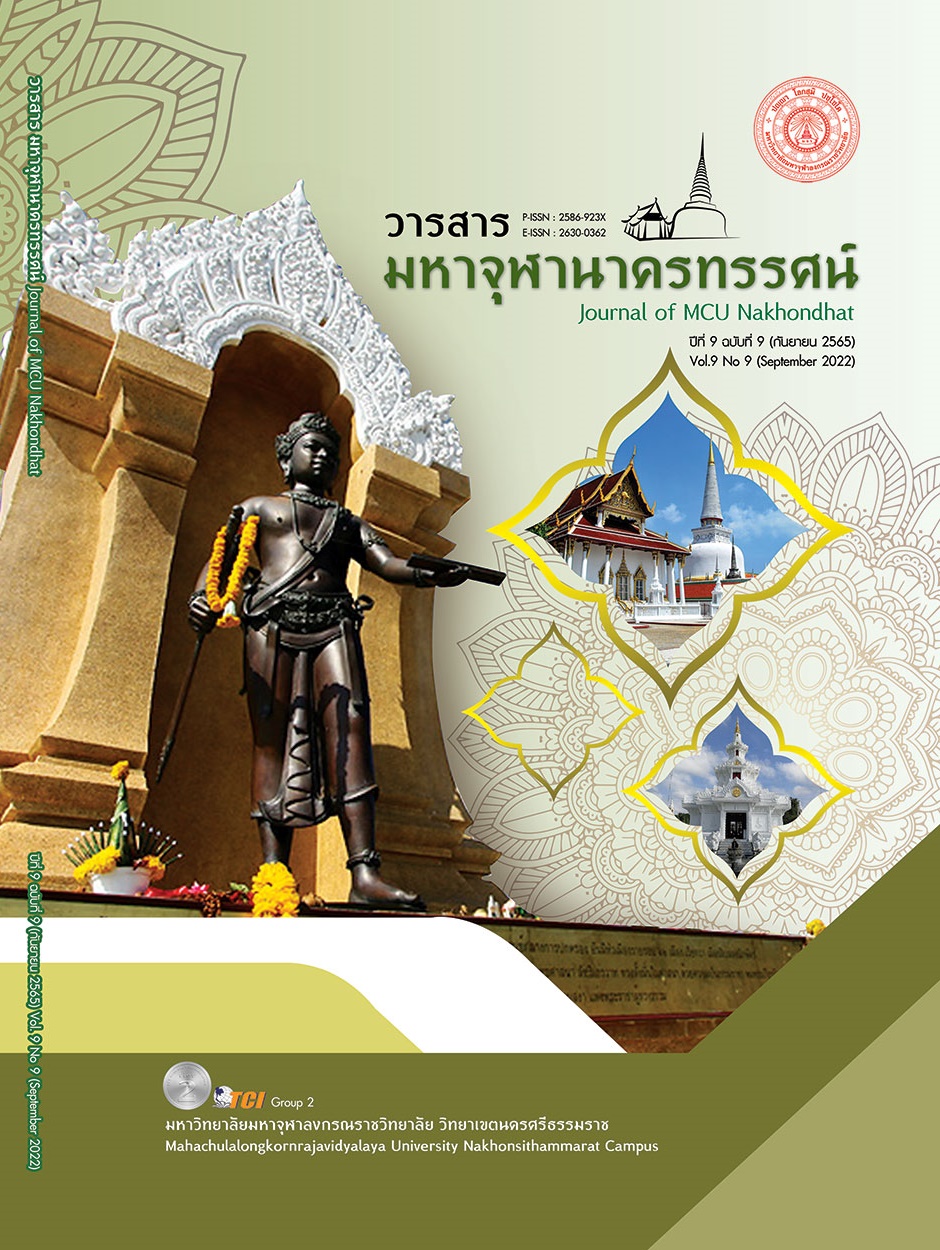FRAILTY IN OLDER ADULTS DURING THE COVID19- PANDEMICS
Main Article Content
Abstract
Thailand will become absolutely an aged society in 2022. Also, the population of older adults in the next 20 years is increasing 3.4 million which is the 5.4 percent of Thai population. Frailty is a common clinical syndrome in older adults that leading to loss of dynamic homeostasis, reducing physiological reserve. The older adults with frailty is resulting in an increase of hospital stay, dependency, and mortality rate compared without non-frailty. Because of the spread of Coronavirus-19, The ministry of public health categorized the older adults are at risk Coronavirus-19 infection. As a result of the older adults with frailty, most of them had comorbidity resulting in risk of infection and severe symptoms which caused by the inflammatory response and decrease immune function. Therefore, The older adults with frailty who infected Coronavirus-19 are resulting in adverse health outcomes, and high mortality rate. Nurses’ role during the pandemic of covid-19 are the important for promoting, preventing, and reducing severity of frailty by the multidisciplinary team collaboration of caring those older adults. Hence, screening, assessing, providing individual care, and reinforcing for self-care in those older adults can improve their health outcomes, and reduce adverse event outcomes.
Article Details

This work is licensed under a Creative Commons Attribution-NonCommercial-NoDerivatives 4.0 International License.
References
กรมการแพทย์. (2563). แนวทางการดูแลผู้สูงอายุในช่วงที่มีการระบาดของเชื้อโควิด-19. เรียกใช้เมื่อ 5 กันยายน 2564 จาก https://covid19.dms.go.th/Content /Select_Landding_page?ContentId=45
กรมกิจการผู้สูงอายุ. (2564). ผู้สูงอายุติดเชื้อ Covid-19 ในประเทศไทย. เรียกใช้เมื่อ 1 กันยายน 2564 จาก https://www.dop.go.th/th/know/side/1/1/857
ชนัดดา อนุพัฒน์ และคณะ. (2563). ปัจจัยที่มีอิทธิพลต่อภาวะเปราะบางในผู้สูงอายุ. วารสารวิจัยทางวิทยาศาสตร์สุขภาพ, 14(1), 43-54.
มูลนิธิสถาบันวิจัยและพัฒนาผู้สูงอายุไทย. (2564). รายงานเรื่องสถานการณ์ผู้สูงอายุไทย พ.ศ.2563. เรียกใช้เมื่อ 5 กันยายน 2564 จาก https://thaitgri.org/?p=39772
ราชวิทยาลัยแพทย์เวชศาสตร์ครอบครัวแห่งประเทศไทย. (2563). แนวทางปฏิบัติการเยี่ยมบ้านและการดูแลสุขภาพประชาชนที่บ้านในสถานการณ์การระบาดของโรคติดเชื้อ ไวรัสโคโรนา 2019 (Coronavirus Disease 2019) หรือ โรคโควิด-19 สำหรับทีม บริการสุขภาพปฐมภูมิ. เรียกใช้เมื่อ 10 กันยายน 2564 จาก https:// thaifammed.org/general-news-and-events/1421/
สุรัยยา หมานมานะ และคณะ. (2563). โรคติดเชื้อไวรัสโคโรนา 2019 (COVID-19). วารสารสถาบันบำราศนราดูร, 14(2), 124-133.
Berg-Weger, M. & Morley, J. E. (2020). Loneliness and social isolation in older adults during. In the Covid-19 pandemic. Implications for gerontological social work.
Chen, X. et al. (2014). Frailty syndrome: an overview. Clinical interventions in aging, 9, 433.
Clegg, A. et al. (2013). Frailty in elderly people. The lancet, 381(9868) 752-762.
Fried, L. P. et al. (2001). Frailty in older adults: evidence for a phenotype. Gerontology Series A: Biological Sciences and Medical Sciences, 56(3), M146-M157.
Gobbens, R. J. et al. (2010). The Tilburg frailty indicator: psychometric properties. Journal of the American Medical Directors Association, 11(5), 344-355.
Gobbens, R. J. et al. (2017). Exploring the efficiency of the Tilburg Frailty In- dicator: a review. Clinical Interventions in Aging, 12, 1739.
Hering, A. et al. (2014). Prospective memory training in older adults and its relevance for successful aging. Psychological research, 78(6), 892-904.
Hewitt, J. et al. (2020). The effect of frailty on survival in patients with COVID-19 (COPE): a multicentre, European, observational cohort study. The Lancet Public Health, 5(8), e444-e451.
Ofori-Asenso, R. et al. (2019). Global incidence of frailty and prefrailty among community-dwelling older adults: a systematic review and meta-analysis. JAMA network open, 2(8), e198398-e198398.
Peng H., & Hsieh C. . (2017). The association between frailty and sleep quality in older adults living in self-paid care homes. Innovation Aging, 1, 1133.
Raiche, M., et al. (2008). PRISMA-7: a case-finding tool to identify older adults with Moderate to severe disabilities. Archives of Gerontology and Geriatrics, 47(1), 9-18.
Rolfson, D. B. et al. (2006). Validity and reliability of the Edmonton Frail Scale. Age and Ageing, 35(5), 526-529.
She, Q. et al. (2021). Frailty Pathogenesis, assessment, and management in older adults with COVID-19. Frontiers in Medicine, 8.
Sinclair, A. J., & Abdelhafiz, A. H. . (2020). Age, frailty and diabetes–triple jeopardy forvulnerability to COVID-19 infection. EClinicalMedicine, 22. 1-2.
Teo, N. et al. (2017). Social frailty and functional disability: Findings from the Singapore Longitudinal Ageing Studies. Journal of the American Medical Directors Association, 18(7), 637-e13.
Uchmanowicz, I., et al. (2018). Frailty Syndrome Nursing Interventions. SAGE Open Nursing, SAGE Open Nursing,4, 1–11.
Van Oostrom, S. H. et al. (2017). A four-domain approach of frailty explored in the Doetinchem Cohort Study. BMC geriatrics, 17(1), 1-11.
Vermeiren, S. et al. (2016). Frailty and the prediction of negative health outcomes: a meta-analysis. Journal of the American Medical Directors Association, 17(12), 1163-e1.
Wongtrakulruang P., et al. (2020). The prevalence of cognitive frailty and pre-frailty amongolder people in Bangkok metropolitan area: a multicenter study of hospital-basedoutpatient clinics. Journal of frailty, sarcopenia and falls, 5(3), 62.
World Health Organization. (2017). WHO Clinical Consortium on Healthy Ageing Topic focus: frailty and intrinsic capacity. Retrieved September 5, 2021, from http:// apps.who.int /irisbitstream/handle/10665/272437/WHO- FWC-ALC17.2eng.pdf?sequence=1&isAlloweng.pdf?sequence=1&is Allowed=y
World Health Organization. (2018). Fact Sheet: Ageing and health 2018. Retrieved September 15, 2021, from http://www.who.int/news-room/fact- sheets/detail/ageing-and-health
World Health Organization. (2021). Coronavirus disease (COVID-19): Risks and safety forolder people. Retrieved September 5, 2021 , from https://www.who.int/news-room/q-a-detail/coronavirus- disease-covid- 19-risks-and-safety-for-older-people


